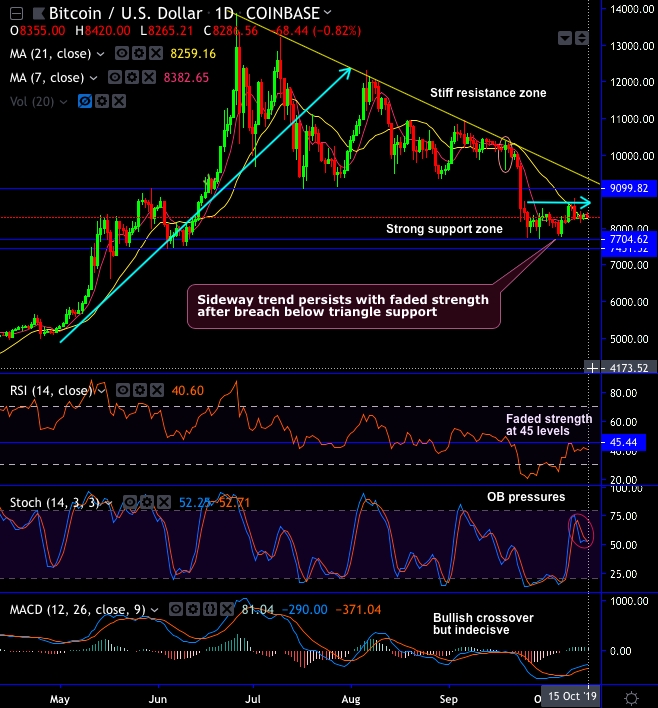Bitcoin prices have been drifting in sideways from the last couple of days, BTCUSD at Coinbase, is oscillating between $8,850 and $7,700 areas since September 25th. Today, the price at the major crypto-exchanges have entered again in this congestion zone (refer 1st chart).
CME Group, the Chicago-based exchange operator, informed its bitcoin futures contracts have developed its fame during the last quarter, they used a twitter handle to inform that their clients’ interest in CME Bitcoin futures remained robust during Q3 2019, with daily open interest (OI) of over 4,600 contracts, up 61% vs Q3 2018, this is owing to the strong interest of institutional investors.
But for now, as you can observe the above nutshell evidencing CME’s bitcoin futures trading volumes and open interests along with the underlying price of BTCUSD that is trading a shy above $8,325 levels, dipping volumes and dipping open interests when price is declining is usually deemed as signal of strength in the underlying asset.
Front-end month contracts shows volumes of 1,774 lots and open interests of 2,184 with change in -21% (refer 2nd chart).
Capitalizing on the prevailing weakness in the underlying price of bitcoin, we reckon that it is wise to deploy the bear calendar spread that has both long and short positions in CME BTC futures contracts but with different expirations.
The strategy is likely to reduce the risk by neutralizing the key driver of the contract’s value. In a bear calendar spread, we sell the short-term contract and buy the long-term contract, the prime objective of this trading strategy is to foresee the spread widen in favor of the short contract.
The execution: At spot reference: $8,299, as we are expecting BTCUSD to slide further over the next month or so, wise to sell BTCV9 contracts at current level and simultaneously buy CME futures of December delivery at the same level. Please be noted that the short-leg requires initial margin per spread.
Target for short-leg is $7,450 and target for long-leg is 11,250 level.
Stop loss for short-leg is $9,100 and stop loss for long-leg is $7,450 level.
The rationale: One can foresee the short contract to increase comparatively more than the long leg, expanding the value of the spread and generating considerable yields. A bear calendar spread is a more conservative position that is less volatile, requiring less margin to set up than a one-leg futures position, and this is a significant advantage of the spread trade. This lower margin requirement allows the trader to achieve a higher return on capital.
With this strategy, one can have umpteen number of ways to win their trades since the spread can enhance in several ways: The long contract slides, when the short-leg inches higher, the long goes down while the short goes up, the long goes down more than the short goes down, and the long goes up less than the short goes up. The important point is that the short October contract becomes more expensive relative to the long December contract.



 FxWirePro- Gold Daily Outlook
FxWirePro- Gold Daily Outlook  12 Solana Memecoins Fail Weeks After Raising $26.7 Million in Presales
12 Solana Memecoins Fail Weeks After Raising $26.7 Million in Presales  The use of AI in war games could change military strategy
The use of AI in war games could change military strategy  How India’s economy has fared under ten years of Narendra Modi
How India’s economy has fared under ten years of Narendra Modi  FxWirePro- Gold Daily Outlook
FxWirePro- Gold Daily Outlook  Nervos network- Multi-layered blockchain
Nervos network- Multi-layered blockchain  Nasa to overhaul mission returning samples from Mars – here’s why it must and will go ahead
Nasa to overhaul mission returning samples from Mars – here’s why it must and will go ahead  Unveiled Nakamoto Emails Shed Light Ahead of Bitcoin's Key Halving Event
Unveiled Nakamoto Emails Shed Light Ahead of Bitcoin's Key Halving Event  Shiba Inu’s Latest Marketing Push Ignites Crypto Buzz in India
Shiba Inu’s Latest Marketing Push Ignites Crypto Buzz in India  Bitcoin Surges Post-Halving: Market Eyes Potential Rally in Altcoins BNB, NEAR, MNT, RNDR
Bitcoin Surges Post-Halving: Market Eyes Potential Rally in Altcoins BNB, NEAR, MNT, RNDR  FxWirePro- Gold Daily Outlook
FxWirePro- Gold Daily Outlook 































